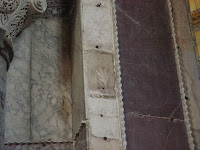 |
| Hittite sun disc in the Museum of Anatolian Civilizations - also being the the symbol of modern Ankara |
Simin Uysal
Over 100 dreams of Hittite dreams have been found recorded on clay
tablets found in Hattusha.
Throughout the Hittite sources, the most frequently named
recipients are the kings, queens and those close to them. Figures appearing in
dreams are gods, goddesses, relatives and friends of the dreamer and ancestors.
The dream messages are various such as a god or goddess demands a new temple,
gifts or rites or expresses anger at an offence. They include warnings for a
king against traveling to a particular city or a future king is told whom he
should marry.
Reading about their dream practices and some translated texts, it
made me smile to learn that a Hittite is never said to "dream" or
"to have a dream" but "to see a dream", "to see in a
dream" or "to see by means of a dream" just like we, the current
inhabitants of the same land still do today. I have to admit that "to have
a dream" has been one of the phrases in English which I have never been
able to understand.
One fascinating fact is the Hittites practiced
dream incubation just as it was practiced in the Asklepions on the western
coast. The most celebrated text about Hittite dream incubation for healing is
the ritual of a woman practitioner named Paskuwatti, designed to treat sexual
impotence. The procedure is written in minute detail and takes place over three
or four days. According to the text, after detailed procedures for
purification, prayers and offerings where in the course of rituals the patient
exchanges symbols of femininity (spindle and distaff) for those of masculinity
(bow and arrows) , the practitioner and the patient move to the house of the
patient for an incubated dream. After preparatory sacrifices and prayers, the
patient lies down with the expectation of a healing dream where a goddess comes
and sleeps with him. If the expected dream comes then votive offerings are made
to the Goddess otherwise the ritual continues.
The Hittites seem to have practiced incubation
widely not only for healing but also for divinatory purposes. The Hittite King was
responsible for worshipping the gods as well as governing the land of Hatti, he
had a central position between the divine and humans. He represented the
human community before the gods and the pantheon before the Hittite
people. In order to fulfill his functions, the king needed to receive and
transmit information between the world of men and that of the gods.
Here is part of a prayer to the gods by king Mursili II
after an ongoing plague for years in the Hatti land. He says, "if people
have been dying because of some other matter, let me either see it in a
dream, or let it be discovered by means of an oracle, or let a prophet
speak of it. Or the priests will sleep long and purely (incubate a dream)
in regard to that which I convey to all of them."
The dreams of the Hittite queen Puduhepa were given special
importance. I can’t help but think that the Sky God and Sun Goddess had equal status
in their pantheon, so did the king and the queen, men and women in the Hittite
culture. In an article by Theo Van Den Hout, Professor of Hittite and Anatolian
Languages, I came across the following precognitive dream of Puduhepa around
the middle of the thirteenth century, where she found herself in the palace
with a prince-like person who tells her he will show her what had happened “in
your house”:
“He led me into some kind of place and there were even some deep
storage pits but it was as if these storage pits had already been emptied out.
Some wooden chests were lying around and in them a lot of old cheese, old figs,
and old raisins had gone bad. Then that prince said: Look, they had already
emptied out what was in the storage pit. They should clean it! So they swept
and cleaned it.”
This dream of the queen was recorded on a clay tablet on the
next day. Her feelings about the dream were not recorded though we know that
they assigned special importance to dreams carrying a high emotional charge. Maybe this is why it has been recorded and archived in the palace.
And less than seventy-five years after she had this dream, the
Hittite Empire collapsed and the ruling class gave up their capital Hattusha.
They left behind all unnecessary things, emptied the palace, storage pits and
left for an unknown destination. When
they left, their language and writing disappeared from Anatolia and with that
their more than five hundred years of history was erased from history for 3,000
years. What was left was swept away when Central Anatolia was left in disarray after they had left until the first millennium when it became part of the Phyrigian Kingdom of King
Midas.
Now, almost 3,200 years later from when the queen’s dream was
recorded, when I wake up in the Hatti Land, I record my own dreams and scan them
carefully for precognitive elements and do much more with them!














